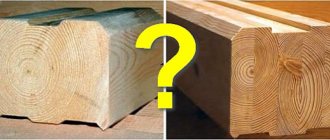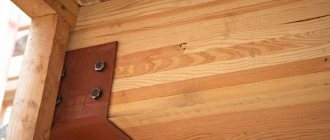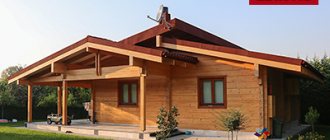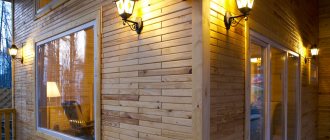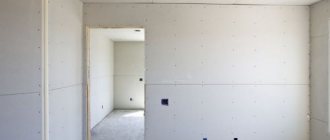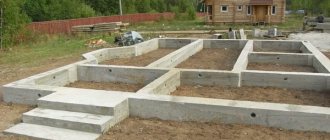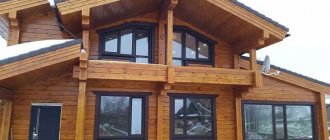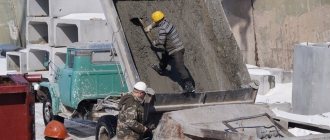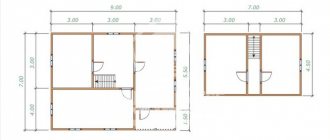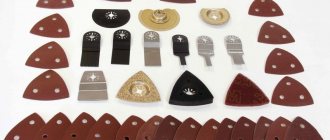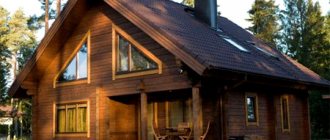What is a warm corner of a timber house, the method of connecting corners from timber, the advantages and disadvantages of a warm corner, the detail of the description of the work, the correctness of sawing out tenons and grooves.
Creating a warm corner of a log house keeps it warm in winter and cool in hot periods. However, the correct execution of the work requires certain knowledge; the article below describes in detail what a warm corner is in creating a wooden house, what a connection with the rest means, what a direct connection means.
What methods exist for connecting corners from timber, how to make a connection into a straight tenon, a half dovetail, an angular tenon, a connection into the floor of a tree and a joint into a paw. Pros and cons of the technology for creating a warm corner. When is it advisable to use a wooden dowel when constructing a wooden structure?
How to mark, how to properly cut grooves and tenons, what to pay close attention to.
What is a warm corner in the construction of a wooden house
A wooden house is a very warm home, but heat leaks still occur, mainly in the joints of timber or logs. Therefore, when building a wooden house, they try to arrange a warm corner of a timber house - this is a special technology for connecting elements, the use of which ensures warm walls and corners of the house. With this connection, the timber fits tightly with adjacent parts, preventing heat from escaping from the premises.
The warm corner joining method is a technology of corner joints in which a figured cut is made in the body of the beam according to special templates: a groove is made in the incoming beam using a sample of wood, and a tenon is cut out in the attached beam. This tongue-and-groove joint forms a sealed corner with no gaps or cracks if the joint dimensions are correct.
Such interfaces are subject to certain requirements, subject to certain parameters:
- High joint strength, which is ensured mainly by the mass of the timber, the weight of the building floors and the mass of the roofing structures. During operation, the beam and the connection of the beam in the corners are exposed to atmospheric phenomena, temperature changes, and wind loads, which causes a change in the linear dimensions of the beam. A house built from timber with natural wood moisture is subject to the greatest fluctuations in size (so-called shrinkage), since damp wood very easily takes any deformation and is subject to maximum internal stresses in the material. Therefore, in construction it is recommended to work with timber with a moisture content of 16-20%, no more;
- A sealed corner connection of the beam is one of the requirements, and if connected correctly, it is one of the advantages of tongue-and-groove interfacing. The requirements for such connections are very simple - they should not allow drafts to pass through. In practice, this looks like a dependence of tightness on complex figures when connecting timber.
Step-by-step instructions: how to build?
The installation of a log house begins with pouring the foundation; there are no particular difficulties here, since the walls of such a building do not create high loads on the foundation of the house.
After the foundation work is completed and the concrete has acquired the required characteristics, before laying the initial row of beams, the foundation is waterproofed by laying horizontally 2 layers of roofing felt on bitumen mastic. Under the first crown you need to place a backing board made of larch 50 mm thick.
Before laying, the backing board and the first crown are treated with antiseptics and fire retardants.
Technology for laying the walls of a winter house:
Each subsequent crown is laid only after tape insulation has been laid on the previous element and secured with a stapler.- The beams are fastened with wooden dowels. To do this, holes are drilled on them at intervals of 1.5 m: the upper one is fully drilled, and the lower one is 1/2 of the thickness. A dowel is inserted into the holes 10 mm deep.
- Regardless of the chosen method of laying the main elements, the first crown is mounted in a “half-tree”, and a “half-tree” is also made at a corner connection using a root tenon.
- After assembling the 1st and 2nd crowns, they begin installing the logs to create the floor in increments of 50-60 cm with a board thickness of 30-40 cm. If the plinth design is possible, then the logs can be laid on it. Otherwise they are cut into the first crown.
- Skull bars are attached to the sides of the logs and shingle boards are placed on them.
- After this, you need to lay out the waterproofing layer surrounding and directly the logs.
- Insulation is placed in the gaps of the logs on the bevel boards and hydraulic layer, and a layer of vapor barrier is placed on top and a subfloor is placed on top.
- Temporary supports made of unedged boards are installed in technological openings for windows and doors.
- Internal partitions are made after the box is built; they are cut into load-bearing walls.
- Roofs are most often gable or sloping, and as
- Mauerlat use the last crown.
- After the completion of the shrinkage processes in the house, the cracks that have appeared on the walls must be well leveled with mastic or caulked.
- After this, they install window units and doors, install utility networks and begin finishing work.
Direct connections
If the beam is shorter than the length of the wall on the larger side, then it is extended, which in itself is a weakening link in the connection. Therefore, it is recommended to purchase timber of the same length as the long side of the house wall.
But, if for some reason this is impossible, then extension is inevitable, and it should be done using one of the methods below so as not to lose strength and tightness:
- End-to-end connection of longitudinal beams with dowels. This splicing makes it possible to minimize the transverse displacement of the beam in all directions and increase the tightness of the interface. In addition, the gaps are sealed using known methods;
- A root tenon connection is an alternative to a keyed timber connection. We have already written about this pairing, but when directly building up a beam, the tenon moves from the end of the beam to the center;
- The oblique lock connection is considered the most labor-intensive and material-intensive method. With such a splice, both beams should overlap in width by two thicknesses, more if possible. The sample sizes must be strictly adhered to.
You should also consider the features of longitudinal fastening of timber with dowels:
- Dowels (tongues) are made approximately 4/5 of the height of the two beams being connected. For a more durable connection along the length, you can use not two, but three dowels for two beams, and it is also allowed to connect three beams with one long dowel;
- The calculated and verified diameter of the dowels is 25-30 mm;
- The distance on the beam between adjacent dowels is ≤ 150 cm;
- The corners of a house made of timber must be fastened with dowels;
- Horizontally, the dowels should be offset - in a checkerboard pattern, and the offset should be applied to all rows relative to each other;
- The best dowels are made from birch. The wood fibers in the hardware must run parallel to the axis. Knots and delamination in the body of the dowel are unacceptable;
- It is advisable to select the material from the core and without obvious defects.
More complex forms of direct splices of timber increase labor costs, but make it possible to achieve the required strength and tightness of the joints without unnecessary material costs. In addition, the connections shown in the figure above eliminate the occurrence of gaps in the seams during shrinkage and operation of the house.
Project development
Drawing up a diagram of a log house requires careful and accurate calculations.
It is quite possible to draw a project with your own hands. Creating a plan consists of several steps, which include their own nuances:
1
Determining the size of the house and its diagram itself
At this stage, it is important to take into account the specific purpose of the premises and the functions that they will perform, as well as all the necessary systems (ventilation, heating, etc.). It is important that rooms with high humidity (kitchen, toilet, bathroom) are located next to each other.
2
Calculation of the quantity of materials. When calculating material consumption, you need to take into account the thickness of the tree, as well as its length. An ordinary beam is six meters long, so if the walls of the house are planned to be longer, it is joined along the length. Many construction companies create custom projects for log houses. When drawing up drawings, all rules are followed. A house built according to such schemes will be geometrically correct and earthquake-resistant. You can also find many photos on the Internet with examples of ready-made schemes for log houses.
The main advantages of a log house
Many houses made of wood have a problem with cold corners. This is due to poor thermal insulation. It is quite difficult to eliminate this phenomenon during operation, so insulation should be taken care of at the time of construction. The warm corner of a log house can be done in several ways. The basic principle of connecting a corner is the absence of any additional fastening elements.
The design itself involves reducing the contact of the surface of the timber with the environment. How to do all this with your own hands will be discussed below.
The simplest and fastest way is to install a warm corner made of timber using profiled materials.
The advantages of this design include:
- Strength - if all the necessary conditions during construction are met correctly, then the stability of the house will be at a high level;
- Low costs – this applies not only to finances, but also to labor. The absence of fastening elements simplifies the assembly process;
- Speed - the technology for making warm corners from timber is simple and high-quality construction does not require a lot of time;
- Thermal insulation - the main property of a log house is considered to be heat preservation; if you compare it with insulation materials (mineral wool, polystyrene foam), then with the same wall thickness a wooden house will be warmer;
- Exterior – a house built from profiled timber looks very organic and does not require additional processing or insulation from the outside.
Building requirements and parameters
The most important parameter that distinguishes the seasonal and winter versions of a house is the heat resistance of wall structures, which is determined by the thickness of the walls.
For summer cottages, external load-bearing walls are installed with a beam thickness of at least 150 mm, and for winter home ownership, the thickness should be at least 270 mm . In the event that a house for permanent residence is being built from timber of a smaller thickness, a multi-layer construction of external walls is provided with the installation of insulation of at least 100 mm.
A house with permanent residence also differs in its level of comfort. SNiP establishes not only the thickness of the walls, but also the size and functionality of the rooms in the house, as well as the mandatory engineering systems that must be installed in it.
The standards establish the smallest areas of living rooms:
living room at least 12 m2;- each sleeping room from 8 m2;
- kitchen from 6 m2;
- shower/bathroom from 1.8 m2;
- hallway from 1.8 m2;
- toilet approximately 1 m2;
- ceiling height from 2.5 m;
- width of stairs and passages over 0.9 m;
- water supply and sanitation;
- heating system with a source: solid fuel, gas or electric boiler;
- power supply systems;
- ventilation and air conditioning systems;
- telephony.
Attic floors may have rooms with a smaller area, for example, for a bedroom a reduction of 1 m2 is allowed.
A winter home must be provided with the minimum acceptable comfort. Utility networks or their equivalents must be connected to it. So, as a drainage system, it is allowed not only to connect to the central water supply system, but also to install cesspools . In this case, filters and cleaning systems for toilets must be provided.
Water supply can be central through an in-house system of plastic or metal water pipes. It is allowed to install individual sources of water supply - artesian wells or wells in the local area.
The heat supply must provide at least + 18 C during the coldest period of the year. The heating system is determined by the project according to the customer’s specifications; it can be either central heating or individual heating with a gas, solid fuel or electric boiler.
Internal heating devices can be either radiator or convector type. Their thermal power is calculated based on the conditions of 10 W per 1 2 total area. For the arrangement of the boiler room, a separate room of at least 5 2 with increased conditions for ventilation and fire protection is allocated.
The ventilation system in such houses is natural-supply, provided by window units. They also provide the required level of illumination. If shower rooms and toilets do not have natural ventilation due to the lack of windows, forced ventilation is installed.
Gasification of timber cottages is carried out from the boiler room or kitchen . The use of gas cylinder units with liquefied gas is allowed with a volume of no more than 12 liters, which are installed in separate non-residential premises in metal boxes.
The supply of electricity, as a rule, is carried out with the installation of overhead power distribution lines. Electrical wiring in the house is carried out in fire-resistant steel pipes.
Fire safety requirements for such houses are complex and begin to apply even at the moment of timber production, when it is treated with fire-resistant solutions. Further, the requirements are divided into functional engineering systems: gas, electricity and heating with a boiler.
Straight tenon
This type of corner connection is well suited for small structures. It is important that more than one timber is not used per length of the building.
Having fulfilled this simple condition, you don’t have to worry about the reliability of the building; it can easily withstand any cataclysm, even an earthquake. With this connection method, the load is distributed evenly between all elements, so the weakened part of the beam will not be exposed to danger.
Evgeniy Filimonov
Ask a Question
An important rule to follow is the ratio of the stud parameters. Its thickness and length should be in proportion 1 to 2 in relation to the main part of the beam.
Half swallowtail
If the house is long enough and it is not possible to use one beam to cover the entire length, a warm corner fastening method called half dovetail is used. Due to this, you can achieve greater strength of the entire house.
Important note! In a half dovetail, the height of the tenon is not allowed to exceed 5 cm, in order to avoid the appearance of cracks in the timber with the groove. This may result from uneven shrinkage.
For a corner connection, part of one beam is sawed into a reverse cone, and an identical cut is made in the second. For a more precise fit of the tenon and mortise, use the same template. In terms of complexity of execution, this connection of timber into a warm corner is not much different from a straight tenon.
Half-tree connection
It is also called a claw joint; the peculiarity of this joint is that it is suitable only for the lower or upper layer of timber. This is due to the fact that a small gap is formed in this corner, which is provided by the technology.
Builders of log houses do not refuse to use this joint for the corners of the house. Due to its reliability and increased strength, the lower layer stands much stronger, and the upper one finally holds the entire structure together.
Important tips to keep the corner of a timber house warm, regardless of the connection method:
- A gap of no more than 5 mm should be left in the joint in order to use it for caulking;
- It is necessary to re-caulk the seams after 4-6 years; this should be done due to the fact that over time the wood shrinks, and the gaps in the joints may increase and begin to let air through;
- If the structure does not have architectural value, then for greater reliability the corners can be covered with thermal insulation film, this will help retain heat.
- By following the rules listed in this article, you can ensure that the corners of your log house will always be warm.
Pros of technology
Correct application of technology contributes to the tightness of the structure, but not only that.
Pros:
- reduction in fastening costs;
- improving the quality of house construction;
- significant reduction in heat loss;
- increased operating efficiency;
- aesthetic significance of the building;
- saving building material.
When dry, profiled timber with natural moisture changes its geometry and can warp or bend. After installation, the wood shrinks in a fixed position, which prevents the timber from deforming. Since cutting out the tongue-and-groove elements is done in advance, at the preparation stage, the assembly of the house itself does not require a lot of time and labor. Anyone can assemble a house with their own hands, saving money.
Evgeniy Filimonov
Ask a Question
At the preliminary stage, you should not refuse consultations with experienced craftsmen; first, you should learn how to make blanks, understand the intricacies of the technological process, and only then, independently assemble a house or bathhouse.
The disadvantages of the technology include the complexity of its implementation. To cut connecting elements correctly with a perfect fit requires practical knowledge and skills. An incorrectly cut tenon during shrinkage can lead to cracking of the timber.
Average prices
Prices for these types of houses depend on the stage at which the project is being completed: “turnkey” or “shrinkage”. You need to pay attention to this when concluding a contract. If with the “shrinkage” option, everything is more or less clear, a box is erected and the roof is built according to the customer’s wishes. But the term “turnkey” in such a house does not mean that the owner can immediately move in and live in it.
In the “key-to-key” version of a dwelling made from professional timber, the customer will receive:
- Floor, window and door packages.
- Walls prepared for interior and exterior finishing work.
- Engineering communications, without instruments. The maximum is temporary lighting in the form of a light bulb.
Average price for turnkey work on a 100 m2 premises:
- for shrinkage from edged timber 150x200 mm with a foundation - 830,000 rubles;
- for shrinkage from professional timber 200x200 mm with a foundation - 930,000 rubles;
- for shrinkage of laminated veneer lumber 200x200 mm with a foundation - 990,000 rubles;
- finishing work - 650,000 rubles;
- heating - 150,000 rubles;
- water supply - 50,000 rubles;
- electricity - 100,000 rubles;
- ventilation - 30,000 rub.
Total:
- turnkey from edged timber 150x200 mm with a foundation - 1,810,000 rubles;
- turnkey made of professional timber 200x200 mm with a foundation - RUB 1,910,000;
- turnkey made of laminated veneer lumber 200x200 mm with a foundation - RUB 1,970,000.
When is it advisable to use a wooden dowel in the construction of timber houses?
So, we've sorted out the warm corner. Now we need to find out what the notorious wooden dowels are and why they are so good!?
Let's start with the fact that wooden dowels are actually wooden nails. Their widespread use in wooden construction, both in the present and in the past, is due to the fact that correctly installed dowels allow walls made of timber with natural moisture to “sit” more or less evenly during the first year of life.
Whereas on hammered nails the timber can “hang”. (however, it can also get stuck on the dowels).
Wooden pins were also used by our grandfathers, who built in Pestovo. The timber houses that we build today are also built using these simple, but often necessary devices. We use wooden dowels in the construction of log houses and bathhouses from profiled timber of natural moisture to prevent the beams from moving.
At the same time, the dowels are installed in such a way as not to interfere with the natural shrinkage of your wooden house. In all rows of timber, our carpenters drill special holes into which dowels are subsequently inserted and tapped - what is important, strictly vertically! It has been proven that a house built in this way produces a minimum number of cracks and is characterized by uniform shrinkage. The process can be considered labor-intensive, but the technology can be called optimal!
Why then iron nails?
Here's why: to work normally with chamber-drying timber. Such timber actually does not shrink - after all, it is dried to 20% humidity. Putting him on the dowels is quite a bit of work. When drying (even with the obligatory presence of longitudinal compensation cuts), the beam slightly changes its geometry, which makes its subsequent assembly on dowels difficult. If you don’t believe me, try it, just take really dry timber! To work with such material, we use metal nails. Many years of empirical experience have proven the validity of this practice.
What types of wood are suitable for permanent residence buildings?
A permanent home must first of all be reliable and warm. In this regard, it is not better to find a beam with a cross-section of 270 mm for this purpose .
However, for the northern and eastern regions it will also need to be insulated with a layer of at least 100 mm.
In this case, the most preferable option would be glued and profiled timber, which has a low percentage of shrinkage, not higher than 2-3%, respectively.
In order to build a warm house, when choosing, the developer will need to pay attention not only to the cross-section of the material, but also to a number of other conditions:
The timber must be made of softwood . Such varieties are more resistant to temperature changes because they have a large amount of resin substances.
They are also natural antiseptics and are able to heal minor cracks, thus reducing the wood’s ability to crack, which means less heat loss from the walls. It is made from wood cut down in winter. During this period, it has only natural humidity, since the movement of moisture through the structure is slowed down, and its remains are simply frozen out naturally.
Advantage of connection
Warm corner connection is one of the types of timber fastening. Its advantages: reliability, efficiency and ease of installation.
The whole essence of the method is to cut a groove 50 mm wide and deep on one side and a tenon 40 mm wide and deep. The remaining distance is filled with insulation. It is better to use jute or felt, this will ensure the best tightness and the absence of cold bridges. The structure is fastened using wooden dowels.
It is also possible to caulk the connection only from the street side. Then there is no need to leave space between the tenon and groove. With this option, the dimensions of the groove will be 40 by 45 millimeters, the tenon 40 by 50 millimeters. The Warm corner connection, or as it is also called Thorn-groove, will provide not only a strong connection of the logs with each other, but will also add visual appeal to the structure as well as good thermal insulation .
Types of corner fastening with remainder
There are the following methods of corner installation with remainder:
To make it clear, let's look at the options in more detail.
"To the brink"
This type of installation involves the presence of two semicircular bowls (for logs). When assembling a log house from a log, this method is also called “in a bowl”. That is, symmetrical recesses are formed, the depth of which is ¼ of the section of the beam, and then the parts are connected according to the lock principle.
"Half a Tree"
Half-tree installation is the simplest type of fastening. It implies the presence of not only a bowl, but also a longitudinal groove filled with insulation - jute, moss or linen. The structure is reinforced with nails or staples. The structure is airtight.
"In the fat tail"
Installation “in the fat tail” presupposes the presence of a transverse recess, groove, mini-protrusions located inside the bowl-pothole, facilitating the construction of a reliable structure.
Warm corner of a log house - technology for successful construction
A house made of profiled timber is the most advantageous construction from all sides. The topic of this article is improving the installation system of a wooden house, achieving clear dry corners thanks to the tongue-and-groove system for assembling lumber.
The described technology allows:
- achieve complete joining of profiled slats;
- obtain reliable insulation of the locking connection in the crowns;
- match universal timber profiles, which greatly facilitates the work and speeds up the laying process.
The “warm corner” of a timber house can be of 2 types:
- No release. Pairing the components into an absolutely even outer corner. This method allows you to save raw materials, rationalize space, and prepare an ideal surface for decorative cladding.
- Happy graduation. A graceful layering of construction sleepers on top of each other, reminiscent of a gorgeous traditional log frame corner. More expensive method. More suitable for frame houses.
The most common families of timber unions are of the following categories:
- root thorn;
- dovetail;
- keyed connection.
Evgeniy Filimonov
Ask a Question
The “warm corner” technology involves cutting the corner in a checkerboard pattern, alternating tenon and groove connections into a lock. Inter-crown insulation of the corner with flax jute allows you to achieve ideal sealing while maintaining the breathable structure of the wood.
You can use other insulation materials such as linen tow, moss or batting. This will reduce construction costs. However, jute fiber has great thermal insulation quality, cannot be transformed, and is light in weight.
By choosing this technology, you pay once. At any stage of progress, you can control the process of assembling your property.
